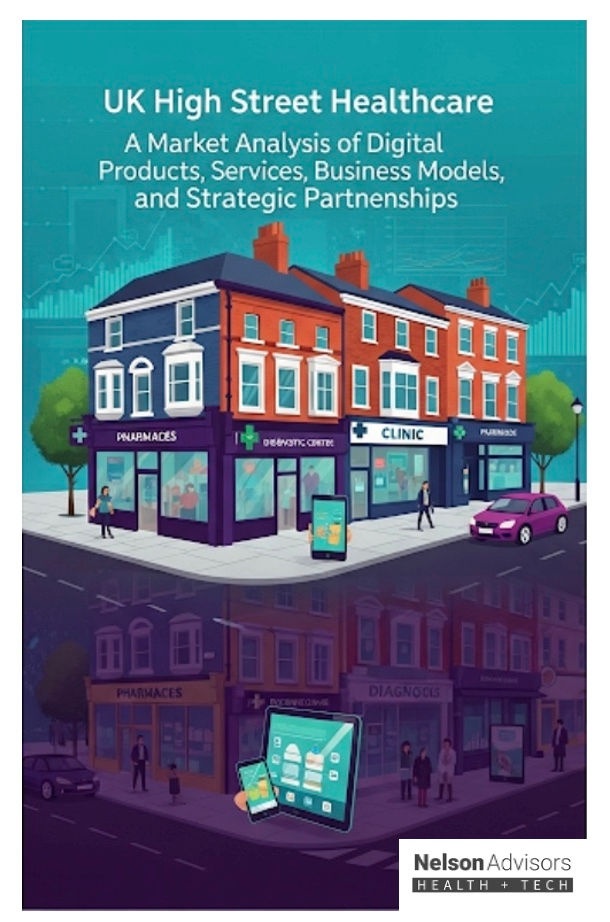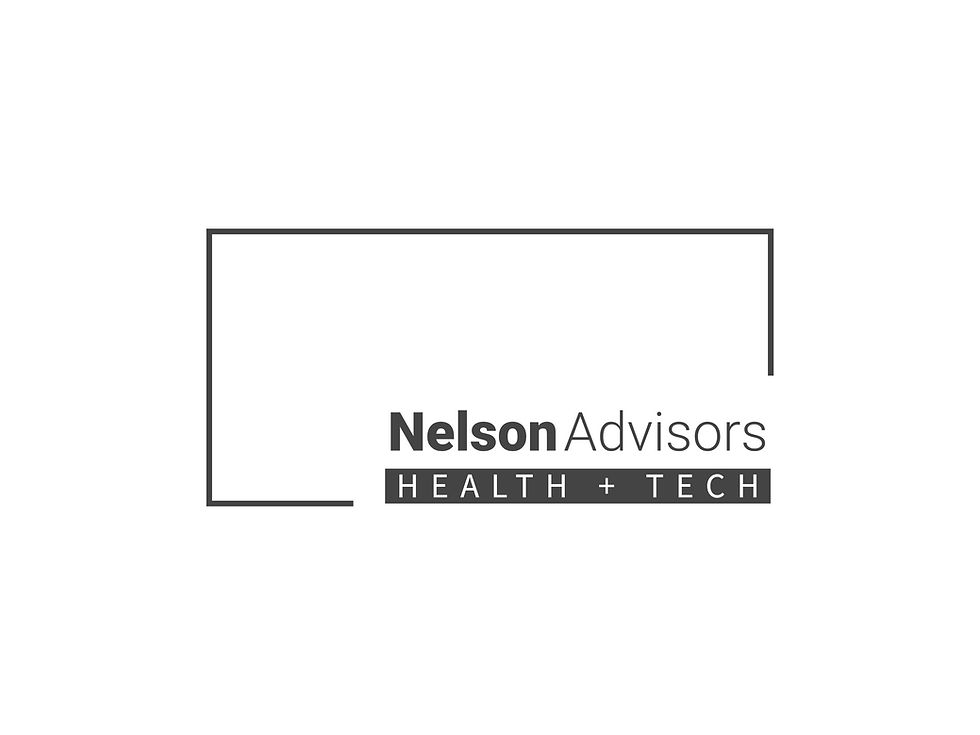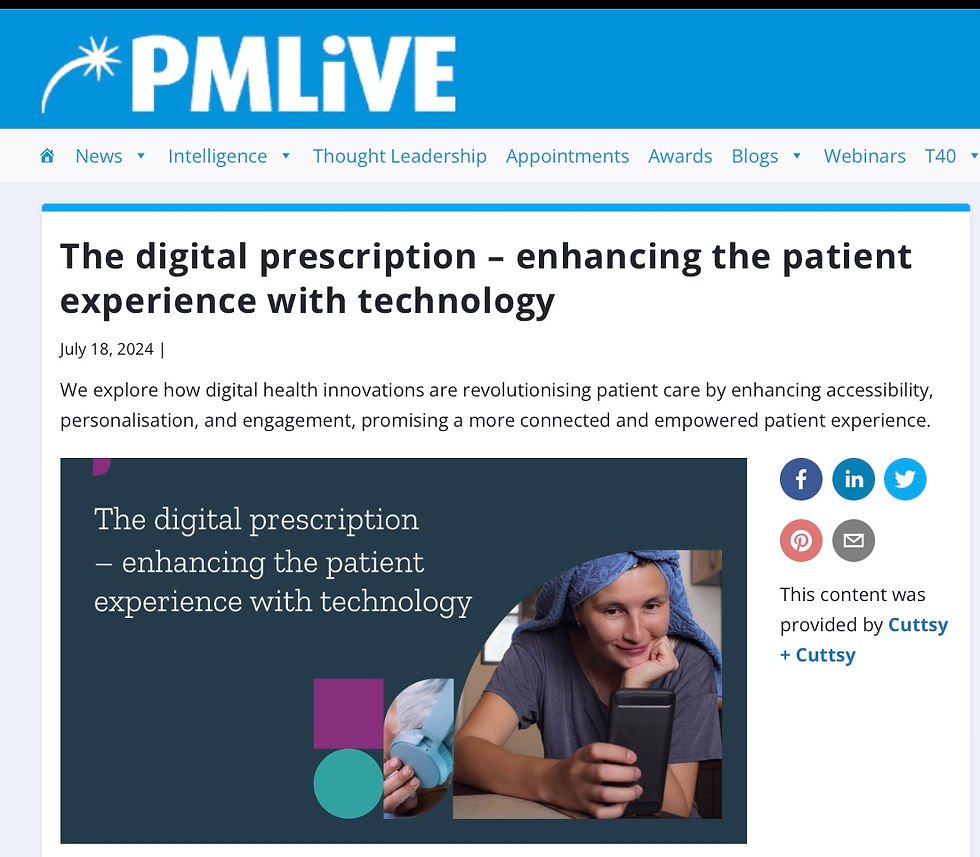UK High Street Healthcare: Market Analysis of Digital Products, Services, Business Models and Strategic Partnerships
- Lloyd Price
- Jul 1
- 31 min read

Executive Summary
The UK high street healthcare sector is undergoing a profound digital transformation, driven by both national health policy imperatives and consumer demand for more accessible and convenient services. This report provides a comprehensive market analysis, detailing the robust growth trajectory of digital health, the evolving business models of key players such as Boots, Superdrug & Specsavers and the critical role of strategic partnerships. The market is projected for substantial expansion, with digital health technologies like tele-healthcare, mobile health and AI-powered solutions leading the charge. This evolution is fundamentally reshaping the traditional high street, moving beyond standalone services to integrated health hubs that alleviate pressure on acute care settings while revitalising local economies.
However, this transformation is not without its challenges.
Cybersecurity concerns, interoperability gaps, and the persistent issue of digital exclusion represent significant hurdles that necessitate strategic mitigation. Key players are responding by adopting hybrid "offline-plus-online" models, investing heavily in digital infrastructure and strategically partnering with technology providers & industry experts. This analysis reveals a dynamic landscape where the National Health Service (NHS) acts as both a powerful market creator and a critical standard-setter, influencing the strategic direction of private providers. The future success of high street healthcare hinges on its ability to seamlessly integrate digital efficiency with personalised human expertise, ensuring equitable access and fostering a holistic approach to community well-being. Strategic recommendations emphasise continued investment in digital literacy, interoperability and collaborative ecosystems to fully realise the potential of a digitally empowered high street healthcare.
1. Introduction to UK High Street Healthcare
1.1 Definition and Evolving Concept of "Health on the High Street"
Historically, UK high streets have accommodated various healthcare services, often as standalone entities like ophthalmology clinics or pathology labs. The contemporary vision of "Health on the High Street" represents a significant evolution, transforming these traditional retail spaces into integrated health hubs. This model involves repurposing town centre buildings, such as vacant retail units or leisure centres, into convenient locations easily accessible via public transport or within walking distance of homes. The core objective extends beyond mere relocation of services; it aims to seamlessly integrate multiple healthcare providers, ranging from "pharmacy first" services to day-case elective surgery, and encompassing preventative programmes for public health issues like obesity, smoking cessation and alcohol abuse.
This strategic shift is designed to address two pressing societal and economic challenges.
Firstly, it seeks to alleviate pressures on main hospital sites by reducing traffic, limiting infection risk and increasing capacity for acute care. By moving non-acute services into community settings, it also helps to tackle growing referral-to-treatment (RTT) waiting times in elective care and diagnostics, supporting initiatives like Community Diagnostic Centres (CDCs).
Secondly, the model actively contributes to town-centre regeneration by driving increased footfall and breathing new life into ailing high streets, garnering strong support from local councils. The high street's influence on public health is multifaceted. While it hosts beneficial services like pharmacies, dentists, opticians, pubs, bars, libraries, and leisure centres, it also contains businesses that can enable poor health behaviours, such as fast-food outlets, payday lenders, bookmakers, and tanning salons. This dual nature underscores a broader understanding: the high street is not just a venue for healthcare transactions but a socio-economic determinant of health. If the physical environment of the high street can inadvertently support detrimental health choices, it equally possesses the potential to actively foster positive health outcomes and community well-being beyond simply housing healthcare providers. This implies that the "Health on the High Street" model is not merely about relocating existing services; it represents an opportunity to transform the high street itself into a holistic health-promoting ecosystem.
This broader perspective suggests a strategic imperative for high street healthcare providers to engage in collaborative efforts with local authorities and other businesses. For instance, advocating for policies such as differential rent classes or business rates relief for health-promoting enterprises, as suggested by public health bodies, could create truly integrated community health hubs that actively contribute to the broader regeneration and public health improvement of the area. This elevates the model from a transactional service delivery approach to one with significant societal impact.
1.2 Context of Digital Transformation in UK Healthcare
The UK healthcare landscape, particularly within the NHS, is experiencing a profound digital transformation. This strategic shift is fundamentally driven by the urgent need to enhance efficiency, manage escalating healthcare costs, and address significant demographic and epidemiological challenges, including an aging population and the rising prevalence of chronic diseases.
Digital technology adoption by both patients and healthcare staff has surged dramatically in recent years. For example, registrations for the NHS App escalated from 2 million in 2021 to 30 million by 2023, with monthly logins exceeding 50 million. This application has become a crucial digital gateway, enabling functions such as prescription reordering, access to test results, and virtual appointment scheduling. These digital interactions have yielded substantial benefits, saving an estimated 1.5 million face-to-face bookings and approximately EUR 622 million (USD $711 million) in avoided administrative costs. Concurrently, there has been a significant expansion of "virtual wards," with official policy targeting 40-50 virtual beds per 100,000 people. Capacity surpassed 10,000 beds by late 2023, treating over 100,000 patients in the first year alone, demonstrating a clear strategic pivot towards remote and at-home care models.
The NHS's 10-year health plan outlines a radical reorientation of service delivery, projecting that "much of what's done in hospital today will be done on the high street, over the phone or through the app in a decade's time". This ambitious plan is underpinned by substantial financial commitments, including a protected £10 billion investment in NHS technology announced in the spending review, alongside an additional £29 billion per year by 2028-2029. Artificial intelligence (AI) is anticipated to "transform everything" within the NHS, from data analytics to resource allocation.
This extensive evidence illustrates that the NHS is not a passive recipient of digital innovation but an active and powerful force shaping the digital health market. It drives transformation through explicit policy objectives, such as "digital-first" approaches and virtual ward expansions, coupled with significant financial investment and direct technology adoption via the NHS App and electronic health record (EHR) targets. This creates a substantial market for digital health solutions. However, the influence of the NHS extends beyond market creation; it also functions as a de facto standard-setter. The majority of healthcare technologies procured in the UK are acquired by the NHS, which means that most manufacturers must adhere to NHS guidelines and regulations. This dual role implies that for high street healthcare providers, aligning their digital strategies with NHS objectives and ensuring interoperability with NHS systems is not merely advantageous but essential for long-term integration and success within the broader UK healthcare ecosystem. The NHS's strategic direction and procurement policies directly influence the viability and scalability of digital health solutions offered by private entities on the high street.
2. UK Digital Health Market Analysis
2.1 Market Size, Growth Trends, and Future Projections
The UK digital health market is experiencing robust growth, signaling a significant and expanding investment landscape. Projections from various market intelligence firms consistently highlight substantial expansion. Mordor Intelligence estimates the market size to grow from USD 15.46 billion in 2025 to USD $36.84 billion by 2030, demonstrating an impressive Compound Annual Growth Rate (CAGR) of 18.96%. A slightly different perspective from IMARC Group values the market at USD 12.8 billion in 2024, forecasting it to reach USD 37.6 billion by 2033, with a CAGR of 12.11% from 2025-2033. These figures underscore a clear upward trajectory for digital health adoption and investment in the UK.
Analysis by technology segment reveals that tele-healthcare held a leading 34.6% market share in 2024, reflecting its current prominence, particularly with the expansion of virtual wards and remote monitoring. Healthcare analytics is projected for rapid growth, with a forecast CAGR of 16.2% through 2030, driven by initiatives such as the Federated Data Platform. In terms of components, software solutions accounted for a 58.2% share of the UK digital health market in 2024. However, services are anticipated to exhibit the fastest growth, with a CAGR of 13.4% to 2030. This indicates that while foundational software remains critical, the implementation, management, and ongoing optimisation of these digital tools are increasingly becoming the primary drivers of market expansion.
This suggests a maturation of the digital health market beyond simply deploying technology; value is increasingly derived from the effective integration and ongoing support of digital solutions within complex healthcare workflows. For high street healthcare providers, this means that acquiring digital products is only the first step; significant investment in the "service layer", including comprehensive training, strategic change management and robust operational support, is essential to fully realise the benefits of these technologies and secure market share.
Regarding application areas, chronic disease management held the largest share at 41.7% in 2024, as the NHS continues to address long-term conditions responsible for a significant proportion of hospital admissions. Diagnostics and decision support are also advancing rapidly, projected at a 15.1% CAGR through 2030, propelled by innovations such as imaging AI tools, clinical triage chatbots and evidence based treatment algorithms.
The following table provides a consolidated overview of the UK Digital Health Market's size, growth projections, and segment breakdowns:
Market Overview | Details |
Market Size (2024/2025) | USD 12.8 Billion (2024) , USD 15.46 Billion (2025) |
Projected Market Size (2030/2033) | USD 36.84 Billion (2030) , USD 37.6 Billion (2033) |
Compound Annual Growth Rate (CAGR) | 18.96% (2025-2030), 12.11% (2025-2033) |
By Technology (2024 Share / CAGR to 2030) | |
Tele-healthcare | 34.6% share (2024) |
Healthcare Analytics | 16.2% CAGR (through 2030) |
By Component (2024 Share / CAGR to 2030) | |
Software Solutions | 58.2% share (2024) |
Services | 13.4% CAGR (to 2030) |
By Application (2024 Share / CAGR to 2030) | |
Chronic Disease Management | 41.7% share (2024) |
Diagnostics and Decision Support | 15.1% CAGR (through 2030) |
2.2 Key Drivers of Digital Health Adoption
The acceleration of digital health adoption in the UK is propelled by a confluence of interconnected factors, forming a reinforcing feedback loop between policy, technology, and tangible benefits.
Firstly, there is a pervasive increase in the overall adoption of digital healthcare solutions, driven by both patient demand for convenience and provider needs for efficiency. This is significantly amplified by the rapid advancements in sophisticated technologies such as Artificial Intelligence (AI), Internet of Things (IoT) and big-data analytics. AI, in particular, is poised to fundamentally reshape the NHS, impacting everything from data analysis and resource allocation to the very nature of clinical interactions.
Secondly, the growing prevalence of mobile-first health applications plays a pivotal role. The remarkable uptake and expanded functionalities of the NHS App, which has become a primary "digital front door" for primary care, exemplify this trend. This widespread adoption indicates a shift in consumer behaviour towards digital engagement for health management.
Thirdly, strategic initiatives from the NHS are actively shaping the digital landscape. The systematic scale-up of "virtual wards" and dedicated "digital-first" funding, alongside digital budgets allocated to Integrated Care Systems (ICS) are actively driving the implementation of remote monitoring and digital care pathways across the country. These top-down directives create a clear mandate and financial incentive for digital transformation.
Furthermore, a supportive regulatory environment and proactive government policies, notably the NHS Long Term Plan, are instrumental in fostering investment in digital care transformation. The UK Department of Health and Social Care has articulated ambitious plans for digital health technology investment, aiming for digitally supported care services to reach 75% of the population by 2023. This favourable policy landscape provides a stable foundation for innovation and market growth.
Cumulatively, digital healthcare offers compelling advantages that fuel its adoption. These include improved access and convenience for patients, reducing travel burdens and wait times, particularly beneficial for those in remote or underserved areas. It enhances the patient experience by empowering individuals to manage their health, access information, and communicate with providers more easily through features like online appointment booking and health record access. From a clinical perspective, real time data from remote monitoring and decision support tools can lead to earlier interventions and more personalised care, improving clinical outcomes. The aggregation of real-world data from mobile health apps and wearables also provides valuable insights into treatment efficacy and safety. Operationally, digital tools enhance efficiency and resource allocation, potentially reducing overall healthcare costs by minimising unnecessary hospital visits and admissions. Moreover, they streamline workflows for healthcare professionals, reducing administrative burdens through electronic records and automated reminders, thereby freeing up time for direct patient care.
These various drivers are not isolated but form a powerful, self-reinforcing cycle. Government policies and NHS strategies create a top-down mandate and a substantial funding environment. This policy impetus then actively incentivizes the development and integration of advanced technologies like AI, IoT and mobile applications. These technological advancements, in turn, enable the realisation of tangible benefits such as improved access, enhanced efficiency, and better clinical outcomes. The demonstration and experience of these benefits then further encourages widespread adoption by both patients and providers, creating a positive feedback loop that generates significant market momentum. This continuous cycle of policy support, technological innovation and demonstrated value is a fundamental characteristic of the UK digital health market, implying that sustained growth relies on the ongoing interplay and reinforcement of these elements. High street players must actively participate in and leverage this cycle to ensure their digital offerings remain relevant, impactful, and aligned with the broader strategic direction of UK healthcare.
2.3 Major Restraints and Challenges
Despite the significant momentum in UK digital health, several substantial restraints and challenges must be navigated for widespread and equitable adoption.
A primary concern revolves around cybersecurity and data privacy. These issues pose a national risk, particularly for major urban healthcare trusts, and are consistently cited as a significant barrier to adoption. Compliance with stringent data protection regulations, such as the UK GDPR and the Privacy and Electronic Communications Regulations (PECR), is paramount, with the Information Commissioner's Office (ICO) possessing considerable enforcement powers and the authority to impose substantial fines for breaches. Clinicians often express uncertainties regarding the legal implications of using health technology, and concerns about data privacy and security can hinder adoption.
Interoperability gaps in legacy NHS IT systems present another significant hurdle. This is a national issue, disproportionately affecting smaller trusts, where the lack of seamless integration between disparate systems, such as electronic health records, digital prescribing and clinical decision support systems, leads to fragmented workflows, data silos and increased administrative burden. This inefficiency can deter clinicians from adopting new technologies, as it adds complexity rather than streamlining processes.
Clinician digital fatigue and resistance to adoption are also notable challenges, particularly pronounced in rural settings.
This resistance often stems from psychological and emotional responses, including anxiety, skepticism, or a general reluctance to change. Past negative experiences with poorly designed systems, a perceived undermining of professional identity by algorithmic support, or a fundamental lack of confidence in navigating new digital tools, especially when adequate training and support are absent, all contribute to this inertia.The perception that learning new technologies is time-consuming further deters adoption.
Patchy rural 5G/broadband infrastructure creates a fundamental barrier to equitable access to digital health services. Many families experience "data poverty," unable to afford reliable Wi-Fi and forced to rely on expensive pay-as-you-go data. This lack of connectivity disproportionately affects rural areas across England, Scotland, Wales and Northern Ireland, limiting the ability of individuals to self-manage their health and well-being.
This leads to the overarching challenge of digital exclusion among the public. A significant portion of the population faces multiple barriers: approximately 7% of UK households lack home internet access, an estimated 10 million adults lack foundational digital skills, and a substantial 30-33% of offline individuals report difficulty interacting with NHS services. This digital divide exacerbates existing health inequalities, leaving vulnerable groups, such as victims of domestic violence, particularly disadvantaged in accessing essential services. Moreover, ethical dilemmas arise concerning the need to ensure equitable access to healthcare technologies and addressing potential biases in algorithm-driven tools, which could inadvertently worsen health disparities.
The pervasive nature of digital exclusion is the primary systemic barrier to achieving the full potential of digital health in the UK. This is not merely a technical issue of lacking devices or internet access; it encompasses a broader deficit in digital skills, a lack of trust in online services, and the compounding effect on health inequalities. For high street healthcare providers, this implies that even the most innovative digital products will struggle to achieve widespread, equitable adoption if these foundational issues of access, affordability, and digital literacy are not comprehensively addressed. This necessitates a strategic focus on providing "assisted digital support" and fostering strong community partnerships, effectively transforming this significant restraint into an opportunity for both social impact and market expansion. Without addressing these fundamental barriers, the promise of universal digital healthcare will remain unfulfilled.
2.4 Emerging Digital Health Sub Sectors
The UK digital health market is characterised by several rapidly expanding sub sectors, each leveraging technology to redefine healthcare delivery:
Tele-healthcare/Virtual Care: This segment currently leads the UK digital health market, accounting for a 34.6% share in 2024. Its growth is significantly bolstered by the systematic scale-up of NHS virtual wards and the increasing deployment of remote monitoring kits, which enable patients to connect with clinicians from their homes. Tele-healthcare encompasses a broad range of services, including remote consultations, diagnosis, and treatment delivered via video calls, telephone, or secure messaging platforms. This approach improves access and convenience for patients, particularly those in remote or underserved areas, and helps to reduce pressure on traditional hospital services.
Mobile Health (mHealth): mHealth refers to the application of portable and smart devices, such as mobile phones, smartwatches, and other wearable technology, for healthcare service provision. This also includes a wide array of healthcare-related mobile applications. These apps serve diverse purposes, including diagnosing, treating, or preventing diseases, monitoring fitness and well-being, providing social care (eg. mental health services or rehabilitation support) and facilitating remote communication between patients and healthcare providers, chronic disease management, or therapeutic interventions.
Health Analytics/Big Data: This sub sector is projected for rapid expansion, with a 16.2% Compound Annual Growth Rate (CAGR). Its growth is significantly catalysed by initiatives like the Palantir-backed Federated Data Platform, which aggregates nationwide data for population health management. Health analytics involves leveraging large datasets to derive insights into treatment efficacy, patient outcomes and pharmacovigilance, supporting evidence-based decision-making and improving understanding of real-world data.
Artificial Intelligence (AI)/Machine Learning-Powered Solutions: AI is anticipated to "transform everything" within the NHS, demonstrating its pervasive potential. Its applications are diverse, ranging from advanced diagnostics and clinical triage chatbots to evidence-based treatment algorithms and optimising resource allocation. These technologies promise to enhance accuracy, efficiency and personalisation of care.
Digitised Health Systems/Electronic Medical Record Management Solutions: This involves the comprehensive digitisation of patient data and prescription delivery across the NHS. A key strategic priority is for all Integrated Care Systems (ICSs) and their NHS trusts to establish core digital capabilities, including electronic health records (EHRs) by March 2025. The ultimate aim is to create a life-long, joined up health and social care record for every individual. This foundational digitisation is critical for streamlining administrative tasks and enabling more personalised care.
Digital Therapeutics & Diagnostics: These areas are advancing rapidly, propelled by innovations such as imaging AI tools and clinical decision support software. These technologies support testing at or close to home, streamline diagnostic pathways, facilitate the triaging of waiting lists and enable faster diagnoses, thereby improving patient access and outcomes.
These emerging subsectors collectively underscore a shift towards more accessible, data-driven and personalised healthcare delivery, with significant implications for high street providers seeking to integrate digital solutions into their offerings.
3. Evolution of High Street Healthcare Services
3.1 Community Pharmacy
Community pharmacies have long been an integral component of the National Health Service (NHS) since its establishment in 1948, though they largely operate as privately provided entities. They possess a well-established history in delivering essential public health services, including programmes for smoking cessation, weight management, sexual health and substance misuse, such as needle and syringe services and supervised consumption of addiction treatments. Furthermore, pharmacies play a crucial role in supporting independent living by assisting individuals with managing their medicines, offering repeat prescription re-ordering, home delivery services for the housebound and re-ablement support following hospital discharge. They also provide NHS Health Checks for individuals aged 40-74, comprehensive vascular risk assessments, and advice to reduce the risk of heart disease, strokes, diabetes and obesity.
A significant development in this sector is the "Pharmacy First" service, launched on January 31, 2024. This service substantially expands the clinical role of community pharmacies, allowing them to complete episodes of care for seven common conditions, including acute otitis media (for ages 1-17), impetigo (1 year and over) and uncomplicated urinary tract infections (women aged 16-64), following defined clinical pathways. Critically, this service enables pharmacists to supply appropriate prescription-only medicines without requiring a prior GP appointment, thereby freeing up valuable GP appointments and providing quicker, more convenient access to healthcare for patients. Patients can access "Pharmacy First" through referrals from general practice, urgent care settings, NHS 111, or by directly contacting the pharmacy.
Beyond "Pharmacy First," pharmacies also offer a range of other advanced NHS services, such as the Lateral Flow Device (LFD) Tests Supply Service, NHS Discharge Medicines Service, NHS Community Pharmacy Blood Pressure Check Service, NHS New Medicine Service, and NHS Pharmacy Contraception Service. They also provide a comprehensive array of private vaccination services, including flu, COVID-19, shingles, chickenpox, Respiratory Syncytial Virus (RSV), pneumonia, MenB, and HPV.
The pharmacy sector has witnessed a notable shift towards e-pharmacy services and digital prescription management. While the number of physical pharmacies in the community saw a reduction between 1963 and 1979, and the NHS reported the lowest number of pharmacies remaining open since 2015 in 2022, this suggests a consolidation or strategic reorientation of operational models rather than a decline in service. The rapid growth of e-pharmacy services is a key trend, with usage surging by over 200% during the COVID-19 pandemic. A study by the Royal Pharmaceutical Society highlighted that one in four UK residents now rely on e-pharmacies for their medication needs, driven by the convenience of online ordering, home delivery and telehealth consultations.
New regulatory guidance, such as the GPhC 2025 guidance for distance pharmacy services, reflects this digital evolution. It emphasises the importance of risk management, premises security and includes detailed requirements for digital platforms, ensuring they are secure, transparent and clearly display pharmacy information.This guidance also provides more specific instructions for managing medicines safely at a distance, verifying patient identity, and ensuring appropriate consultation methods.
The expansion of services like "Pharmacy First" represents a policy-driven delegation of minor ailment care from General Practitioners to community pharmacies. Concurrently, the significant growth in e-pharmacy adoption and the evolving regulatory framework for digital pharmacy services indicate a fundamental transformation in how patients access medication and advice. The observed decline in the number of physical pharmacies, alongside this digital surge, suggests a strategic consolidation and re-prioritisation within the sector. This transformation positions high street pharmacies, especially those with robust digital platforms, to evolve from traditional dispensing points into digital-first primary care navigators. They are leveraging technology to offer convenient access to a broader range of clinical services, manage prescriptions, and provide health advice, thereby playing a crucial role in alleviating NHS primary care pressures and redefining the patient's initial point of contact within the healthcare system. This strategic evolution aligns closely with the NHS's broader shift from hospital-centric to community-based care and from analogue to digital delivery.
3.2 Optometry
The provision of eye care services in the UK has a rich history, with the NHS initially offering free eye examinations and spectacles for children and adults from 1948 to 1986. This early scheme, while providing much-needed access to care, faced challenges due to overwhelming public demand, leading to extensive waiting lists of up to 18 months and significant costs. The focus was primarily on functionality over fashion, with a limited range of robust frames that, over time, unfortunately became associated with a social stigma. In 1986, the NHS ceased manufacturing glasses and introduced a voucher scheme, which remains in place today. Currently, free NHS sight tests are available to qualifying UK residents and are universally free in Scotland, a policy that has led to a notable increase in eye examinations. Eligible patients receive an NHS optical voucher, the value of which is determined by their prescription and this can be redeemed at any accepting supplier.
The UK optical goods market is experiencing consistent growth, with an estimated value of £3.83 billion in 2023. Projections anticipate this market will surpass £4 billion by 2028 and reach approximately £7.32 billion by 2030, demonstrating a Compound Annual Growth Rate (CAGR) of 6.7% from 2024 to 2030. This growth is partly attributable to an increased demand for prescription glasses and contact lenses, with almost half (47%) of British people reporting a purchase in 2023.
Opticians are increasingly integrating digital tools to enhance both convenience and the patient experience. This includes the provision of online consultation services, such as Specsavers' RemoteCare, which offers advice via video or phone. Online booking for eye tests is now commonplace, alongside comprehensive online shopping platforms for purchasing glasses and contact lenses. A particularly popular digital feature, especially among younger consumers (68% of 18-34 year olds), is virtual try-on technology. This innovation helps to simplify the overwhelming choice of styles and significantly improves the efficiency and enjoyment of the shopping experience.
A growing consumer awareness and concern surrounds the effects of extended screen time on eye health, with over half (54%) of consumers expressing worry about this issue. This concern creates a significant demand for preventative care, educational resources, and specialised solutions to address digital eye strain.
Historically, optometry was largely a reactive service, primarily focused on correcting existing vision problems. However, the current market growth is not solely driven by an increase in prescriptions but is substantially influenced by a rising consumer awareness and concern regarding the impact of extended screen time on ocular health. This indicates a fundamental shift in consumer mindset from a purely reactive approach to a proactive focus on digital eye health management in an increasingly digitally saturated world. This implies that digital tools in optometry are not merely about convenience, such as online booking or virtual try-on features. Instead, they present a strategic opportunity for opticians to position themselves as experts in digital eye health. This involves offering specialised solutions, providing educational resources, and delivering preventative care related to screen fatigue, blue light exposure and the long-term effects of digital device use. By addressing these growing, digitally-driven health concerns, opticians can expand their service offerings beyond traditional sight tests and product sales, thereby capturing a new and expanding segment of the market.

4. Key Players: Digital Products, Services, and Business Models
The UK high street healthcare market is significantly shaped by major players like Boots, Superdrug and Specsavers, each leveraging digital innovation to evolve their business models and service offerings.
4.1 Boots
Boots, often described as a "pharmacy supermarket," operates an extensive network of over 2,000 high-street and shopping centre locations, strategically blending traditional retail (e.g., cosmetics, groceries) with comprehensive pharmaceutical services. This model positions Boots as a convenient, one-stop destination, effectively driving significant footfall even in an era of declining high streets. The integration of modern services such as in-store vaccinations, diagnostics and digital prescriptions has modernised its image and helped maintain high customer traffic. Boots has successfully cultivated a recurring revenue model within a traditionally transactional environment by increasing its share of sales from private health services and subscription plans.
This hybrid "pharmacy supermarket" model is not merely a retail strategy; it functions as a powerful competitive advantage in the evolving healthcare landscape. By capitalising on its extensive physical presence and established consumer trust, Boots can deliver a seamless "offline-plus-online" experience that pure digital players find challenging to replicate. This approach enables Boots to capture a broader customer journey, encompassing everything from routine shopping to urgent health needs, and to convert one-off transactions into long-term, recurring customer relationships. This synergy between physical and digital channels enhances Boots' resilience to market shifts and uniquely positions it to serve both digitally-savvy and digitally-excluded consumers, thereby effectively future-proofing its high street presence.
Digital Health Services
Boots Online Doctor: This is a private online healthcare provider, regulated by the Care Quality Commission (CQC) and the Regulation and Quality Improvement Authority (RQIA). It offers online consultations, private treatments, and home test kits for over 45 common health conditions, including sexual health, weight loss, women's health, men's health, and acne/skin conditions. Patients can choose to collect prescribed medicines at a local Boots store or opt for Royal Mail delivery, providing convenient and discreet care without the need for a physical doctor's visit.
Boots Health Hub: Accessible via boots.com, this digital platform provides customers with access to over 80 healthcare services. These include various healthcare tests, COVID-19 services, a wide range of vaccinations, prescription services, and even integrated online general practitioner consultations through Livi.
NHS Prescription Services: Boots offers a convenient 24/7 online ordering system for NHS repeat prescriptions. Key features include click & collect at any Boots pharmacy, free delivery, end-to-end prescription tracking, and re-order reminders (for England only). It also fully supports the NHS electronic prescription service.
In-store NHS Services: Boots actively participates in and supports numerous NHS services within its physical stores. This includes the new NHS Pharmacy First Service, offering advice and treatment for seven common health conditions, as well as the NHS Blood Pressure Check Service, NHS Stop Smoking Service, NHS New Medicine Service, and NHS Discharge Medicines Review Service. Additionally, Boots provides a comprehensive range of private vaccination services, such as Shingles, Chickenpox, Respiratory Syncytial Virus (RSV), Pneumonia, MenB, and HPV.
Digital Infrastructure and Online Sales Growth
Boots' robust digital infrastructure has been instrumental in supporting an 18.7% increase in online sales. Its mobile app facilitates a wide array of services, from booking flu shots to managing repeat prescriptions. A significant digital transformation initiative involved a partnership with UST to implement a "Single View of the Customer." This project integrated over 100 legacy platforms containing 130 million customer records, enabling an omnichannel, customer-focused value proposition. This comprehensive view allows for tailored offerings and communications based on individual customer history, preferences, and consents, leading to increased average basket value and higher email open rates. Crucially, pharmacists can now access this consolidated data (with appropriate patient consent) to provide more personalised advice and referrals.
To enhance accessibility, Boots became the first retailer in the UK and Republic of Ireland to integrate Recite Me technology into its online store. This feature caters to over 13 million people facing online shopping barriers by providing screen reading functionality, multiple reading aids, and on-demand live translation in over 100 languages. Furthermore, Boots has strategically partnered with the
College of Healthcare Information Management Executives (CHIME) and the Healthcare Information and Management Systems Society (HIMSS). These collaborations aim to accredit Boots team members as "digital healthcare leaders" and provide webinars for in-store teams on the future of digital healthcare, fostering internal innovation and ensuring staff are equipped for technological shifts.
4.2 Superdrug
Superdrug has established a strong presence on the high street as a health and beauty retailer, increasingly integrating digital solutions into its service delivery.
Online Pharmacy and Prescription Services
Superdrug offers a "Hassle-Free NHS Prescriptions" service online, enabling customers to order, track, and receive reminders for their medication with ease. Prescriptions can be collected in-store or delivered nationwide across England, Scotland, and Wales. While delivery charges apply for single or subscription deliveries, free delivery is available for eligible customers, including the housebound, those with severe mobility issues, or immunocompromised individuals. Superdrug also provides both NHS and private flu vaccination services.
Digital Features
Superdrug App: The Superdrug app is a central component of its digital strategy, allowing customers to shop for thousands of health and beauty products, create wish lists, and utilise a fast and secure checkout. Crucially, the app features a "Health Services Hub" where users can directly book appointments with doctors and health clinics, order prescriptions from their GP for collection at a local pharmacy, and access the Superdrug online doctor service for advice and treatments spanning women's and men's health, wellbeing, travel advice, and testing services.
Health & Beautycard: This loyalty program offers significant benefits, including free delivery on orders over £20 and exclusive lower prices on selected products both in-store and online. The "VIP Rewards" program further incentivises customer engagement by unlocking additional benefits based on spending.
In-store Digital Screens: Superdrug is rolling out approximately 500 high-tech digital screens across its UK store network. These screens are designed to provide customers with "relevant information, product news and exciting offers" while serving as a retail media network (Optimo) for suppliers to deliver personalised advertisements. This initiative is a critical element of Superdrug's "Offline plus Online strategy," aiming to seamlessly integrate its online presence with its physical stores.
Investment in Healthcare Ambassador Program and Offline-Plus-Online Strategy
Superdrug is actively transforming its high street healthcare proposition through a significant £1 Million investment in a new "Healthcare Ambassador programme". This initiative involves highly training dedicated members of staff in various healthcare categories, such as vitamins and medicated skincare. These trained ambassadors will be stationed in healthcare aisles across 51 stores, with plans to expand to 75 by the end of the year, providing in-person healthcare advice, support, and product recommendations. This programme is a direct response to the "growing demand for more immediate access to health expertise" and is designed to place the customer's health and wellbeing at the core of its framework.
This substantial investment in human expertise, despite heavy digital investments, indicates a strategic recognition that there remains a critical need for human interaction, empathy, and trusted, in-person advice on the high street, particularly for health-related queries. This approach suggests that digital transformation in healthcare is not about replacing human contact but rather about augmenting and enabling it, creating a differentiated value proposition that combines digital efficiency with personalised, expert human support. This strategy aims to enhance customer trust and loyalty in a competitive market by reinforcing Superdrug's "clear commitment and steadfast belief in the ongoing development, innovation and success of its high street healthcare offering" amidst economic challenges.
Strategic Partnerships
Superdrug has entered a new partnership with Positive Solutions, a leading provider of pharmacy technology solutions. This collaboration involves the implementation of Positive Solutions' comprehensive technology suite, including Analyst PMR, mobile scanning apps, and the innovative Hx ecosystem, across Superdrug's 183 pharmacy stores. The primary goals are to streamline dispensing workflows, significantly reduce staff time (by up to 45 hours per week per store), and enable pharmacists to dedicate more focus to patient care by automating previously manual tasks and facilitating cloud-based, anytime-anywhere service delivery. Additionally, the rollout of Superdrug's in-store digital screens is managed in collaboration with
Optimo, as part of its broader Retail Media Network.
4.3 Specsavers
Specsavers has established itself as a leading provider of eye and hearing care on the UK high street, distinguished by its innovative joint venture partnership model. This model enables each store to be part-owned and managed by its partners (opticians and audiologists) who are shareholders of their own businesses. These partners receive comprehensive support from central specialists in areas such as marketing, accounting, IT and wholesaling, allowing them to focus primarily on delivering expert eye and hearing care. Specsavers is also a significant provider of NHS eye and hearing health services, conducting over half of all NHS eye tests and glasses dispenses in the UK. Many of its stores offer additional NHS services, including hearing care, glaucoma services and urgent care for minor eye injuries.
Online Eye and Hearing Care Services
RemoteCare: Specsavers offers a free online consultation service via video or phone for individuals seeking sight or hearing advice, extending this service even to non-customers. This feature is particularly beneficial for those who are isolating or shielding.
Online Shopping: Customers can conveniently purchase prescription glasses online by providing a current prescription, with virtual try-on technology available to assist in style selection. Additionally, contact lenses can be bought online with free delivery and an express re-order function, alongside a limited selection of contact lens solutions.
Audiology Remote Services: Specsavers provides free online hearing checks, enables the online purchase of hearing aid batteries and offers remote fine-tuning of hearing aids, enhancing accessibility for hearing care.
Online Appointment Booking: Customers can easily book eye tests, hearing tests & contact lens appointments online and even request home visits for those unable to attend a store.
Investment in Practice Upgrades and Digital Enhancements:
Specsavers is undertaking a substantial investment programme, committing over £64 million (equivalent to more than £85,000 per day) across its network of UK and Ireland optometry practices. This investment is directed towards upgrading practice interiors, enhancing illuminated product displays, and installing digital screens to "enhance the customer experience". Over 650 practices are slated for refreshment over a two year period, with 500 already completed. The strategic goals of these improvements are to deliver more accessible patient care, bolster the high street presence, motivate staff, and create an inviting environment that encourages patient retention and repeat visits.
Strategic Partnerships
A pivotal strategic move for Specsavers has been its selection of eClinicalWorks, a US-based provider specialising in cloud-based electronic patient records (EPR) and patient engagement platforms. This partnership involves implementing a single, global EPR system across all 500 UK stores and an additional 1,200 international locations. This deal represents a significant entry into the UK market for eClinicalWorks and is designed to streamline Specsavers' operations, crucially linking customers' vision and hearing information directly with the retail side of the business. The objective is to support online booking and enhance the overall convenience of online healthcare services.
This comprehensive data integration, achieved through the eClinicalWorks partnership, positions Specsavers to transcend its traditional focus on optometry and audiology. By establishing a unified, accessible view of customer clinical data alongside their purchasing history, Specsavers gains the capability to develop more personalised, preventative and potentially broader healthcare services. This robust data backbone is critical for future advancements, including the potential for AI-driven diagnostics, highly tailored product recommendations and even strategic expansion into other high street health offerings, mirroring the "pharmacy supermarket" model observed with Boots. This transforms Specsavers' business from a series of transactional encounters into a continuous, data-informed health relationship, laying a strong foundation for future health ecosystem expansion.
The following table provides a comparative overview of the key digital services offered by Boots, Superdrug, and Specsavers:
Feature | Boots | Superdrug | Specsavers |
Core Business Model | Pharmacy Supermarket, Health & Beauty Retailer | Health & Beauty Retailer, Pharmacy | Optician & Audiologist (Joint Venture Partnership) |
Online Consultations/Telehealth | Boots Online Doctor (45+ conditions), Livi GP integration | Superdrug Online Doctor (women's/men's health, wellbeing, travel, testing) | RemoteCare (video/phone for sight/hearing advice) |
Online Prescription/ Medication Management | NHS repeat prescriptions (ordering, tracking, delivery, reminders); Private prescriptions | NHS repeat prescriptions (ordering, tracking, delivery, reminders) | N/A (not a pharmacy) |
Home Test Kits/Diagnostics | Boots Online Doctor (various tests), MyHealthChecked | Superdrug Online Doctor (testing services) | N/A (focus on in-store diagnostics) |
Online Product Sales (Glasses/Lenses/Health Products) | Extensive health & beauty products, medicines | Extensive health & beauty products, medicines | Prescription glasses, contact lenses, hearing aid batteries |
Mobile App Features | Prescription ordering, flu shot booking, general health services | Health Services Hub (booking, prescriptions, online doctor), Health & Beautycard, VIP Rewards | Online appointment booking, home visit requests |
In-store Digital Integration | Digital screens, upgraded interiors | 500 new digital screens for info/ads, upgraded interiors | Upgraded practice interiors, illuminated product displays, digital screens |
Key NHS Service Integration | Pharmacy First, Blood Pressure, Stop Smoking, New Medicine, Discharge Medicines, various vaccinations | Flu vaccinations (NHS & Private) | Over half of all NHS eye tests & glasses dispenses, hearing care, glaucoma, urgent eye care |
Unique Digital/Hybrid Initiatives | Boots Health Hub (80+ services), Recite Me accessibility tech | £1M Healthcare Ambassador programme (in-store expert advice), Offline plus Online strategy | Virtual try-on for glasses, Remote hearing aid fine-tuning |
Key Digital Partnerships | UST (Single View of Customer), CHIME/HIMSS (digital leadership training), The Doctors Laboratory (test kits) | Positive Solutions (pharmacy tech suite), Optimo (retail media network) | eClinicalWorks (global EPR system) |
5. Strategic Partnerships and Innovation Ecosystem
5.1 Collaborations Driving Digital Transformation
The digital transformation within UK high street healthcare is significantly propelled by strategic collaborations between key players and specialised technology providers, as well as industry bodies. These partnerships are crucial for enhancing digital capabilities, streamlining operations, and expanding service offerings.
Boots:
Boots has engaged in several pivotal partnerships to bolster its digital infrastructure and service delivery. Its collaboration with UST for the "Single View of the Customer" initiative is a prime example. This partnership involved integrating over 100 legacy platforms and 130 million customer records, enabling an omnichannel, customer-centric approach that has led to increased average basket values and more effective personalised communications. Furthermore, Boots has partnered with the College of Healthcare Information Management Executives (CHIME) and the Healthcare Information and Management Systems Society (HIMSS).
These collaborations are designed to accredit Boots team members as "digital healthcare leaders" and provide them with insights into the future of digital healthcare through webinars. This proactive approach fosters internal innovation and ensures that staff are well-equipped to navigate and contribute to technological shifts. The Boots Health Hub also integrates Livi's online general practitioner consultations, indicating a strategic alliance to broaden virtual GP access for its customer base. Additionally, Boots partners with The Doctors Laboratory in London for the processing of samples from its home test kits, ensuring reliable diagnostic services.
Superdrug:
Superdrug has made significant strides in digitalizing its pharmacy operations through strategic partnerships. A notable collaboration is with Positive Solutions, a leading provider of pharmacy technology solutions. This new partnership, which replaced a 22-year relationship with a previous supplier, involved the implementation of Positive Solutions' comprehensive technology suite, including Analyst PMR, mobile scanning apps, and the innovative Hx ecosystem, across Superdrug's 183 pharmacy stores. The primary aim is to streamline dispensing workflows, significantly reduce staff time (by up to 45 hours per week per store), and empower pharmacists to focus more on patient care by automating manual tasks and enabling cloud-based service delivery. Superdrug's rollout of 500 in-store digital screens, part of its Retail Media Network, is conducted in collaboration with Optimo, enhancing personalised advertising and integrating its offline and online presence.
Specsavers:
Specsavers has strategically invested in a robust digital backbone for its global operations. It selected eClinicalWorks, a US supplier specialising in cloud-based electronic patient records (EPR) and patient engagement platforms. This partnership is establishing a single, global EPR system across Specsavers' 1,700+ stores internationally, including 500 in the UK. The deal is intended to streamline operations, crucially linking customers' vision and hearing information with the retail side of the business, and facilitating convenient online healthcare services such as online booking. This collaboration represents a significant entry point for eClinicalWorks into the UK market and underscores Specsavers' commitment to a unified, data-driven approach to patient care and retail.
5.2 Role of Technology Providers and External Expertise
The array of partnerships detailed above unequivocally highlights the critical role played by specialized technology providers in enabling complex digital transformations for large high street retailers. Companies like UST (for customer relationship management), Positive Solutions (for pharmacy technology), and eClinicalWorks (for electronic patient records) bring indispensable infrastructure, sophisticated software, and deep domain expertise that internal teams within these retail giants might lack. This external support is instrumental in accelerating deployment cycles, ensuring the development of robust and scalable digital solutions, and facilitating the seamless integration of new technologies into existing operational frameworks.
Furthermore, collaborations with industry bodies and educational programs, such as those undertaken by Boots with CHIME and HIMSS, underscore the profound importance of external expertise in upskilling internal teams. These initiatives are not merely about technical training; they are designed to foster a culture of innovation, encourage employees to conceptualise and implement new digital healthcare initiatives, and ensure that the workforce remains abreast of broader healthcare technology trends and best practices. This approach ensures that digital transformation is perceived not just as a technology rollout but as a fundamental shift in organisational capability and strategic direction.
The consistent pattern of these major high street players actively engaging with specialised technology providers and industry bodies, rather than attempting to build all digital capabilities in-house, reflects a strategic imperative to "partner for agility and specialisation." In a rapidly evolving digital health landscape, where technological advancements are constant and regulatory requirements are complex, relying on external experts allows these companies to quickly adopt cutting-edge solutions without the prohibitive costs and time associated with in-house development. This approach enables them to remain agile in responding to market demands and technological shifts, leverage specialised knowledge to optimise their digital offerings, and ultimately enhance their competitive edge by focusing internal resources on core business functions while external partners manage the complexities of digital infrastructure and innovation. This collaborative ecosystem is therefore a cornerstone of successful digital transformation in high street healthcare.
Summary
The UK high street healthcare sector is in the midst of a profound and irreversible digital transformation, driven by a convergence of policy mandates, technological advancements, and evolving consumer expectations. The market for digital health solutions is experiencing robust growth, with projections indicating significant expansion over the next decade. This growth is particularly evident in areas such as tele-healthcare, mobile health and AI-powered diagnostics, reflecting a broader shift towards more accessible, efficient, and personalised care models.
A key dynamic shaping this landscape is the dual role of the National Health Service. The NHS acts as both a powerful market creator, through its strategic investments and "digital-first" policies, and a de facto standard-setter, influencing the development and adoption of technologies across the private sector. For high street providers, aligning digital strategies with NHS objectives and ensuring interoperability with national systems is therefore crucial for long-term integration and success.
The evolution of traditional high street services, particularly community pharmacies and opticians, exemplifies this transformation. Pharmacies are moving beyond dispensing roles to become digital-first primary care navigators, leveraging services like "Pharmacy First" and e-pharmacy platforms to alleviate pressure on general practices. Similarly, opticians are expanding their focus from reactive vision correction to proactive digital eye health management, addressing growing consumer concerns related to screen time through integrated digital tools and specialised services.
Leading high street players—Boots, Superdrug, and Specsavers—are actively embracing hybrid "offline-plus-online" business models. Boots, with its "pharmacy supermarket" approach, leverages its extensive physical footprint and established trust to create a competitive advantage, seamlessly integrating online consultations, prescription management, and in-store services. Superdrug is strategically reasserting the value of human expertise through initiatives like its Healthcare Ambassador programme, recognizing that digital convenience is best augmented by personalised, in-person advice. Specsavers is building a data-driven clinical-retail integration through a global electronic patient record system, laying the foundation for future expansion into broader health ecosystems.
Despite the promising trajectory, significant challenges persist. Cybersecurity and data privacy concerns, coupled with persistent interoperability gaps in legacy IT systems, pose operational and regulatory hurdles. Crucially, digital exclusion remains a systemic barrier, impacting a substantial portion of the population due to lack of access, skills, or trust. Addressing this digital divide through "assisted digital support" and community partnerships is not just a social imperative but a strategic necessity for achieving equitable and widespread adoption of digital health services.
The strategic imperative for high street healthcare providers is to "partner for agility and specialisation." By collaborating with specialised technology providers and leveraging external expertise, these companies can rapidly deploy cutting-edge solutions, streamline operations, and enhance their digital capabilities without the extensive in-house investment. This collaborative ecosystem is vital for navigating the complexities of the digital health market, fostering continuous innovation and ensuring that high street healthcare remains relevant and responsive to the evolving needs of the UK population.The future success of high street healthcare will depend on its ability to integrate digital efficiency with trusted human interaction, creating a truly holistic and accessible health ecosystem.
Nelson Advisors > Healthcare Technology M&A
Nelson Advisors specialise in mergers, acquisitions & partnerships for Digital Health, HealthTech, Health IT, Consumer HealthTech, Healthcare Cybersecurity, Healthcare AI companies based in the UK, Europe and North America. www.nelsonadvisors.co.uk
Nelson Advisors regularly publish Healthcare Technology thought leadership articles covering market insights, trends, analysis & predictions @ https://www.healthcare.digital
We share our views on the latest Healthcare Technology mergers, acquisitions & partnerships with insights, analysis and predictions in our LinkedIn Newsletter every week, subscribe today! https://lnkd.in/e5hTp_xb
Founders for Founders > We pride ourselves on our DNA as ‘HealthTech entrepreneurs advising HealthTech entrepreneurs.’ Nelson Advisors partner with entrepreneurs, boards and investors to maximise shareholder value and investment returns. www.nelsonadvisors.co.uk
#NelsonAdvisors #HealthTech #DigitalHealth #HealthIT #Cybersecurity #HealthcareAI #ConsumerHealthTech #Mergers #Acquisitions #Partnerships #Growth #Strategy #NHS #UK #Europe #USA #VentureCapital #PrivateEquity #Founders #BuySide #SellSide
Nelson Advisors LLP
Hale House, 76-78 Portland Place, Marylebone, London, W1B 1NT
Contact Us
Meet Us
Digital Health Rewired > 18-19th March 2025 > Birmingham, UK
NHS ConfedExpo > 11-12th June 2025 > Manchester, UK
HLTH Europe > 16-19th June 2025, Amsterdam, Netherlands
HIMSS AI in Healthcare > 10-11th July 2025, New York, USA
World Health Summit 2025 > October 12-14th 2025, Berlin, Germany
HLTH USA 2025 > October 18th-22nd 2025, Las Vegas, USA
MEDICA 2025 > November 11-14th 2025, Düsseldorf, Germany





















































Comments